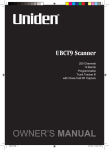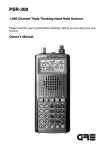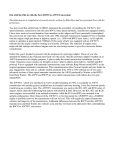Download TCI 360000 TRANS-SCAT
Transcript
TCI 360000 TRANS-SCAT® Installation Instructions for FORD C-6 Transmissions TCI®’s TRANS-SCAT® kit will allow you to calibrate the performance of your transmission. This kit has two options — a High-Performance Street/Strip or a Severe Duty for your driving needs. All automatic functions are retained in the Drive position. Selecting the High-Performance option will provide a firm, definite shift. The transmission will shift with a "snap" and is recommended for performance Street/Strip applications. When the vehicle will be used in high-load conditions, then the selection of the Severe Duty package is recommended. Our kit will extend and improve transmission life of RV’s, campers, motor homes, taxicabs, police and vehicles used for towing. This option will provide a more positive shift over stock but It will not be too abrupt or harsh. NOTE: The TCI® TRANS-SCAT® kit will not repair a transmission that is not working properly. For best results, use only in transmissions that have been maintained properly and are functioning correctly. Parts Check List C-6 TRANS-SCAT® 1 1/8’ Drill 1 Servo Modulator Valve 1 Check Ball – ¼" 4 Springs: Blue: Pressure Regulator (‘67-‘74) Orange: Pressure Regulator (‘75 & Later) Violet 2-1 Scheduling Valve Spring Plain: Accumulator Valve Spring 1 Pan Gasket 1 Separator Plate 1 Filter 1 Filter Gasket (See Illustration #1) Tools Necessary for Installation: 3/8" Drive Ratchet or Speed Handle 3/8" Drive Sockets: ½"- 3/8"- (12-Point); 5/16" 13/16’ Wrench Torque Wrench: 0 - 250 inch/pounds 1/4’ Drill Small Screwdriver Small File (NOTE: 12 inch/pounds = 1 foot/pound) Illustration 1 Before you start this project, be sure to read the directions carefully. Familiarize yourself with this instruction sheet, photographs, and illustrations. This kit can be installed easily, but If this is your first time, you may need to refer to a motor/service manual for more detailed instructions. Newspaper or cardboard can be used to provide a good work surface over a bench top. You will need a drain pan, some boxes/containers to hold and separate transmission parts, and clean shop rags. Transmission parts are designed to fit with precision. They should not be FORCED, PRIED or BEAT into place. Allow your vehicle to cool several hours if you have been operating the vehicle. Hot oil and parts can cause bums. The vehicle should be raised off the ground and supported with the proper type of stands. REMOVAL AND DISASSEMBLY NOTE: The transmission does not have to be removed for installation of TCI® Trans-Scat® Kit. STEP 1. Removing Oil Pan. Before you remove the oil pan, it will be necessary to drain the oil first. To do so, remove the back oil pan bolts and work toward the front. Let the back of the pan drop so the fluid will drain. (NOTE: Some vehicles may require removal of the crossmember to remove the transmission pan.) If the pan sticks to the gasket, use a screwdriver to loosen the pan from the case. After the fluid has drained, remove the rest of the bolts. Be careful when removing the pan because there will be fluid retained in the pan and the transmission. Once the pan has been removed, wash and clean gasket material from pan. Since the pan does not have a drain plug, you may want to take the time to install a TCI® 805800 — Drain Plug Kit into the pan. This will save you time in servicing your transmission in the future. STEP 2. Removing Valve Body. Remove the eight (8) valve body attaching bolts and pull the valve body straight down. (See Illustration #2). Lay the valve body on a clean work bench with the filter side down. Remove the two upper bolts. (See Illustration #3). NOTE: Mark the short bolts and the long bolts so you will remember where the bolts belong. Turn the valve body over and remove the nine- (9) filter retaining bolts. (See Illustration #4). You will see that eight of the bolts are the same size plus one longer bolt. Mark this bolt for easy installation. Remove filter and gasket. Next, remove seven (7) valve body bolts remaining. (See Illustration #5). You will have six (6) short bolts and one long bolt, mark these bolts. Illustration 2 Illustration 3 Illustration 4 Illustration 5 Recap of Valve Body Bolts: Socket Size Qty. Description (5/16") 8 Attaching Bolts (5/16") 2 Upper Bolts-(1 short----1 long) (5/16") 9 Filter retaining Bolts (8 short---1 long) (3/8") 7 Valve Body Bolts (6 short—1 long STEP 3. Valve Body Disassembly. Basically there are three parts of the valve body: 1. Upper Valve Body (Contains valves and check balls) 2. Separator Plate and Gasket 3. Lower Valve Body (Filter attaches to this section) When you separate these parts, be careful not to loose any check balls or springs. Turn the valve body so the lower half will be facing upward. Remove the lower half and separator plate. Clean the lower half of the valve body for use in reassembly. You now have the bottom part of the upper valve body exposed. (See Illustration #6). Illustration 6 Before you turn the valve body over, you will need to remove the converter check valve assembly: 9/32" relief ball (Early production) or relief valve (Late production) and the relief (fine) spring. Remove the throttle pressure check ball assembly: ¼" relief ball and relief (coarse) spring. Remove the 2-3 shift valve check ball. In 1977-81 valve body you will remove down shift valve retainer, pressure boost valve sleeve, retainer and reverse clutch check ball. (See Illustration #6). STEP 4. Removing Pressure Regulator Assembly. (See Illustration #7). Year Valve Body No. P/R Springs TCI® Replacement * 1966--67 One Blue * 1968--71 Two Blue * 1972—76 Two Blue ** 1977 & Later Two Orange * Bolts ** Retainer Clip ‘68-’87: Remove the two bolts holding Pressure Regulator End Plate onto valve body. Remove carefully because springs are pushing against the plate. Remove sleeve, pressure boost valve and outer pressure regulator spring. (NOTE: ‘66-67 will not have an inner spring). Replace outer spring with Blue TCI® spring. Reinstall assembly. Make sure assembly is seated properly. Reinstall end plate and torque to 30-45 inch/pounds. ‘77 and Later Push booster sleeve in slightly and remove retaining clip with a screwdriver. Relieve the pressure and remove booster sleeve, pressure boost valve, and outer pressure regulator spring. Replace with Orange TCI® spring. Reinstall assembly using retaining clip. Clip will fit in seating area. STEP 5. Removing Throttle Boost End Plate. Remove the two (2) bolts that hold throttle boost end plate to valve body. Remove carefully because springs are pushing against plate. Remove only manual low 2-1 scheduling valve spring. (See Illustration #7). Replace with Violet TCI® spring. Reinstall assembly and end plate. Torque bolts to 30-45 inch/pounds. Illustration 7 STEP 6. Removing Valve End Plate (Long End Plate). Hold valve body up, so when end plate is removed, valves and springs will not fall out. Remove the eight (8) bolts that hold plate to valve body. Remove carefully because springs are pushing against plate. Remove as follows: A. Intermediate Servo Modulator Spring. All models. Remove and replace with TCI® plug supplied with this kit. Servo plug must not stick out of valve body casting. If plug is not below plate contact area, remove plug and grind surface down slightly. Remember to deburr and clean before reinstalling into valve body. B. Intermediate Servo Accumulator Springs. All models. Remove inner and outer springs and replace with one (1) Plain TCI® spring. (NOTE: ‘66-67 models may have only one spring.) C. Cut-Back Valve. Severe Duty: No modifications Street/Strip: Remove cut-back valve and install 1/4’ TCI® check ball into valve bore, then replace cut-back valve. Reinstall end plate. Be sure that each valve assembly is pushed into place. Torque all eight (8) bolts to 30-45 inch/ pounds. STEP 7. Now turn valve body over to reinstall valve assemblies and check balls. (See Illustration #5). Install converter check valve assembly: 9/32" relief ball (Early production) or relief valve (Late production) and relief (fine) spring into bore. Install throttle pressure check ball assembly: 1/4" relief ball and relief (coarse) spring. In 1977-81 valve body reinstall down shift valve retainer, pressure boost valve sleeve, retainer and reverse clutch check ball. Severe Duty: Install 2-3 check ball into bore. Street/Strip: Do not install 2-3 check ball. STEP 8. Separator Plate. Take your old separator plate and compare with Illustration #8. On the diagram you will see two (2) holes indicated. One of these will match a hole that is already in your separator plate. Mark this hole. Next, take the new TCI® separator plate and mark the position of the hole from your old plate. Using the 1/8" drill supplied in this kit, drill a new hole in the TCI® separator plate. You will no longer need your old plate. Clean and deburr the hole. STEP 9. Reassembly of Valve Body. Before you start, make sure that the valve body parts are clean and free of any debris or gasket material. (Dirt or gasket material could cause the valve body to not function properly.) Install the separator plate onto the lower valve body. Do not use a gasket between the two plates. Install the hold down plates. (See Illustration #9). Note location of stud bolt. Once plates are in proper location, torque bolts to 30-45 inch/pounds. Install lower valve body onto upper valve body. Holding the valve body halves together install the six (6) short bolts and the one (1) long bolt. (See Illustration #5). Tighten and torque bolts to 3045 inch/pounds. Next install new filter and gasket. Install eight (8) long filter bolts and one (1) extra long bolt. (See IllustratIon #4). Align the two large valve body bolt holes with the lower valve body. Tighten and torque bolts to 30-45 Inch/pounds. Turn valve body over and install short bolt and long bolt. (See IllustratIon #3). Tighten and torque bolts to 30-45 inch/ pounds. Your valve body should now be complete. STEP 10. Adjustment of Front Transmission Band. When making the intermediate band adjustment, the lock nut may need to be replaced. The lock nut has a molded seal element that prevents fluid leakage past the adjusting screw thread. Adjustment and readjustment can cause the sealing material to not seal positively. Loosen the lock nut using a 13/16" wrench. Torque the screw to 120 inch/pounds. Back the screw off exactly 1 1/2 turns. Hold the adjustment and torque the lock nut to 35-45 foot/pounds. (See Illustration #10). STEP 11. Installing Valve Body Into Transmission. When reinstalling the valve body, it is very important that the internal linkage engages the valve body properly. Put the valve body into the transmission, engaging the shift and kickdown linkage. Holding the valve body in place, install the valve body attaching and retaining bolts. (See Illustration #4 for long bolt position). Tighten the bolts finger tight and check operation of the kickdown and shifter linkage. If linkage engages properly, torque bolts to 95-125 inch/ pounds. Nothing should bind and the valve body should fit flat against the case. Check engagement of levers. Failure of proper installation can cause damage to the valve body, transmission and/or linkage. Until you are confident that this part is working correctly—DO NOT PROCEED—redo this step or get help from someone that has transmission experience. STEP 12. Install clean transmission pan and new pan gasket. Tighten and torque bolts to 12-16 inch/pounds. STEP 13. ShIfter Adjustment. Make sure that the transmission selector lever and manual lever detent positions match. Place transmission selector lever in Drive (D) position. Place transmission manual lever in Drive (D) position. Loosen lock rod retaining nut located on shift rod and align shifter and transmission in Drive position and torque bolts to 10-12 foot/pounds. STEP 14. Kickdown Adjustment. The kickdown system should come in when the accelerator is pressed through detent, and not before detent. You may need someone to help you make this adjustment. Depress gas pedal and make sure that the carburetor is wide open throttle. If not, adjustment is necessary. Disconnect downshift lever return spring. Hold downshift rod against through detent stop (wide open throttle). Adjust downshift screw to provide approximately 1/16" clearance between screw and throttle arm. Connect downshift lever spring. (See Illustration #10). Illustration 10 Illustration 9 STEP 15. Adding Transmission Fluid and fluid Check. Lower vehicle. Rear wheels should not touch the ground. Add four (4) quarts of TCI® RTF Fluid or a good grade of Type F Automatic Transmission Fluid. Place shifter in Neutral (N) position and start engine. Let engine run a few minutes and then check fluid level with transmission dipstick. Now add fluid until the level will touch the "ADD" mark on your dipstick. Now shift the transmission through all drive and reverse positions. Your rear wheels will be turning. After you have allowed the transmission to shift and run through all the gears, recheck the fluid level. Do not add more fluid unless level is below "ADD" mark. STEP 15. Road Test. Drive your vehicle moderately, shifting through all the gears for one or two miles to warm fluid properly. After you have driven your vehicle, recheck the fluid level and add the necessary amount of fluid to reach the "FULL" mark on your dipstick. (DO NOT OVERFILL! This can cause foaming, overheating and blow by. Transmission fluid capacity will vary with application. Approximately 12 to 13 1/2 quarts are used in most standard dry applications when converter is being replaced. If using old converter it will not be necessary to use as much fluid due to the converter retaining some of the fluid. It will only be necessary to replace approximately 6 to 8 quarts of fluid depending on your particular application and the size of the pan. IMPORTANT: Remember to service your transmission regularly and TCI® recommends using a transmission cooler for better performance over the life of your vehicle. TROUBLE SHOOTING GUIDE FOR FORD C-6 TRANSMISSIONS Malfunction: Possible Cause: Transmission Overheats Fluid Foaming at Dipstick, Tube Fluid Foaming at Breather Improper Fluid Level Restriction in Cooler Lines Cooler Size Insufficient Improper Band or Clutch Application Transmission Slips Improper Fluid Level Pressure Regulator Valve Assembly Improperly Installed. Booster Valve Assembly Improperly Installed Valve Body Loose End Plate Bolts Loose Linkage Adjusted Improperly Erratic Shifting Linkage Adjusted Improperly Improper Fluid Level Vacuum Line Improperly Installed Vacuum Line Cracked or Leaking Valve Body Bolts Loose End Plate Bolts Loose Late Hard Shifts Linkage Adjusted Improperly Vacuum Line Cracked or Leaking Modulator Damaged Incorrect Engine Idle Intermediate Band Needs Adjusting Early Soft Shifts Modulator Rod Missing or Incorrect Alignment Improper Fluid Level Incorrect Engine Idle Will Not Shift Valve Body Bolts Loose End Plate Bolts Loose Linkage Not Connected Sticking Governor Valve One Gear Only Shifter Not Engaged Properly Linkage Adjusted Improperly Back to Top 02/2000

















